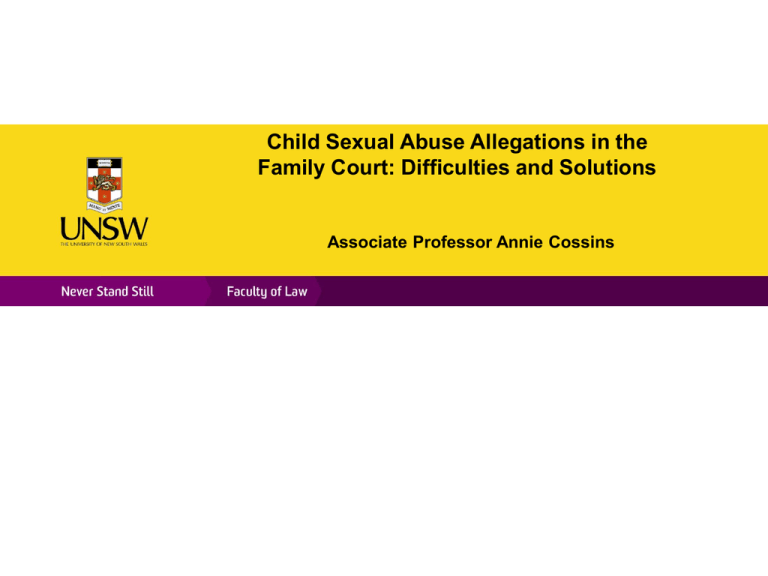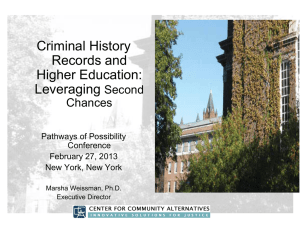
Child Sexual Abuse Allegations in the
Family Court: Difficulties and Solutions
Associate Professor Annie Cossins
How should CSA allegations be dealt with?
Criminal versus civil jurisdictions
it is an unacceptable oddity in this 21st Century that the criminal processes … place the
entire evidentiary burden of proof of … [child sexual assault charges] upon the
evidence of a child …, whereas other courts making equally important determinations
on the same topic of the sexual abuse of children by family … routinely … gain
information from many other sources, and positively discourage the concept that the
truth can be ascertained by the cross examination of a child. [T]he practices and
procedures of the [the Family Court] … are far more a search for the truth than the
procedures of the State criminal courts. … [I]n cases of this nature, the focus of the
inquiry ought to be upon what has happened in the child’s life rather than upon proof
of a criminal charge, although the enquiry into what has happened may well establish
that a criminal offence has been committed; and the procedures routinely used in the
criminal jurisdiction should be radically reconsidered. This would require a paradigm
shift .
(R v D [2002] QCA 445 at [44]-[46], per Jerrard JA).
Myths or realities?
Are the women who make allegations of CSA against their
husbands, “drama queens” acting out revenge (The Courier-Mail, 14
December 2012)?
Or does the Family Court routinely ignore the risk of a child being
sexually abused by her/his father? (The Age, 17 August 2011; The
Herald-Sun, 15 March 2012)?
Questions posed by these competing
claims
1.
Should an allegation of CSA in the Family Court be both a civil
and criminal matter ?
2.
Could CSA allegations arising out of marital breakdown be
dealt with in a single court that has the power to exercise both
civil and criminal jurisdictions?
3.
A single court with both civil and criminal jurisdictions would
require a paradigm shift.
Integrated Domestic Violence Courts:
New York
Integrated Domestic Violence Courts (“IDV”) use a “one family-one judge”
model to bring before a single judge the multiple criminal, family (civil) and
matrimonial (divorce) disputes for families where domestic violence is an
underlying issue.
Rationale : previously those affected by domestic violence had to navigate
different courts in different jurisdictions and in different buildings, causing
increased costs, time, confusion and jeopardizing victim safety.
Aim : one judge adjudicating multiple cases ensures informed decisionmaking and consistency in judicial orders, with improved responses to the
particularities of a family’s situation and enhancement of services to victims
and families. It also increases court efficiency, victim safety and speedier
dispositions.
Staffing: IDV Courts are staffed with judges trained in multiple areas of law
and the dynamics of domestic violence. They incorporate ongoing judicial
monitoring of offenders.
Source: http://www.nycourts.gov/courts/problem_solving/idv/home.shtml
Integrated Domestic Violence Courts
jurisdiction
IDV Courts are established in the Supreme Court.
Participation in the IDV Courts is voluntary. To be eligible, a family must
have a criminal domestic violence case as well as a family court case, a
matrimonial case, or both, where at least one of the defendant and
complaining witness to the criminal case is also a party to the family or
matrimonial case.
The most common family court case types in IDV Courts are family offense
and custody or visitation, which account for about 85% of family cases in
IDV court.
Some IDV Courts also take support, abuse and neglect, or paternity cases.
Misdemeanors represent the bulk of criminal cases in IDV Courts, although
the courts also have the power to hear felony-level criminal cases.
Source: http://www.nycourts.gov/courts/problem_solving/idv/home.shtml
Selection for Integrated Domestic
Violence
Courts
The presiding judge reviews
eligible cases
and determines whether transfer
from their original jurisdiction would promote the administration of justice
based on Part 141 of the Rules of the Chief Administrator, the statewide IDV
Court model and the facts of the particular cases.
If the IDV judge transfers the cases, they all become Supreme Court cases.
However, the cases do not merge and are handled separately based on the
evidence in the case. IDV Courts apply to each case the substantive and
procedural law including the relevant standards of proof that would have
applied in the case’s original jurisdiction.
Since their inception, IDV Courts have handled over 146,291 cases and
served over 27,816 families. As at 1 March 2013, there are 45 IDV Courts in
operation in New York.
Source: http://www.nycourts.gov/courts/problem_solving/idv/home.shtml
CSA context
Most CSA cases involve:
(a) an offender who is known or related to the child;
(b) grooming by the offender over time to engage a child’s trust and test her/his
reactions to non-sexual and sexual touching;
(c) a relationship of dependence, control, or power between the child and the
offender;
(d) no eye- or earwitnesses to the actual sexual contact;
(e) delayed complaint; and
(f) no forensic evidence such as the presence of semen or medical evidence of
penetration.
For example Johnson (2004) reported that ‘‘as many as 96% of children
assessed for suspected sexual abuse will have normal genital and anal
examinations’’.
Patterns of disclosure of sexually abused
children
In a twenty literature review (Cossins, 2010), I found that:
the vast majority of children do not report within 5 to 10 years of the
occurrence of the sexual abuse
Stranger abuse is a key predictor of rapid disclosure
Children abused by family members are more likely to delay disclosure
longer than one month
Repeated abuse is more likely to occur if the abuser is a relative
Children who experience multiple abuse are less likely to disclose
Less intrusive forms of abuse are more likely to be reported
The younger the child at onset of abuse, the less likely she or he will
disclose
What the literature says about serial offending
In a recent literature review (Cossins, 2011) involving 20
recidivism studies over 16 years, I found the following—that:
(i)
the commonly quoted recidivism rate for child sex offenders
of between 10 to 20 per cent is a substantial
underestimation.
(ii)
these rates are remarkably similar to the estimated
likelihood of an offender being convicted once a report is
made to the police which, in Australia, is 8 to 10 per cent.
(ii)
the problem with studies that use reconviction as their
measure, is that they do not take into account the fact that a
majority of children only disclose sexual abuse from 5 to
10 years after it has occurred, or not at all
(iii)
studies using charge rates, rearrest rates and self-report
data from offenders show that actual recidivism rates are
more than twice those estimated by reconviction data.
The characteristics of child sex offender behaviour
Compared to rapists, child sex offenders are much more likely than
rapists to ‘specialise’ in sex offences, meaning they are more likely to
be repeat sex offenders and to have multiple victims.
Re-offending is committed by significant proportions of child sex
offenders.
The most accurate recidivism estimates show that:
(i)
about 5 to 30 per cent of low-risk offenders will re-offend
(ii)
90 per cent or more of high-risk offenders (which includes
both intra- and extra-familial offenders) will re-offend.
The literatures tells us that the best predictors of child sex offending is
a previous report, charge, arrest or conviction for child sex offending in
the offender’s background.
A dual civil/criminal jurisdiction would mean:
This information means that key questions should be asked when a
mother alleges her child has been sexually abused in the Family
Court:
Will a criminal investigation reveal whether there are previous
reports of CSA by other children against the defendant?
Will a criminal investigation reveal other victims who are willing to
come forward and report abuse by the defendant?
Does the defendant have a record of prior arrests, charges and/or
convictions for child sexual abuse?
Will a criminal investigation reveal that the defendant uses, produces
and/or disseminates child pornography (also a predictor of sex
offending)?
Will a criminal investigation reveal prior family relationships of the
defendant in which allegations of CSA were made?
Multiple victims and diversity in sexual behaviour
Child sex offenders’ is more varied in terms of the number of victims
and types of sexual behaviour than the legal fraternity may realise.
Their sexual misconduct is best described as a continuum of sexual
behaviours—
beginning with non-sexual touching,
moving to less serious sexual touching to test out a child’s reactions,
and then progressing to more serious sexual acts
The progression will depend on:
(i)
the child’s age and sex
(ii) access to the child and opportunities for being alone
(iii) the child’s resistance
(iv) successful use of emotional manipulation, coercion or threats.











